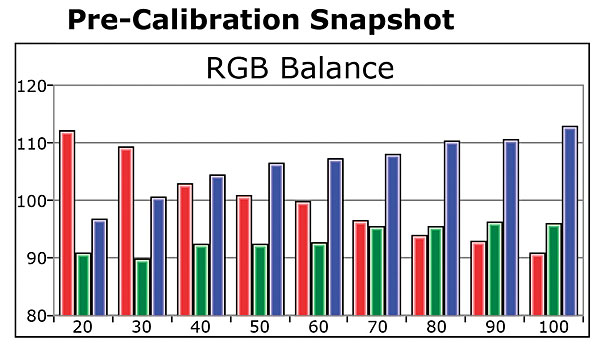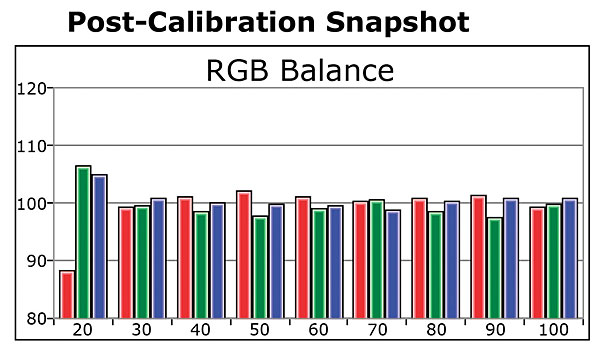Epson PowerLite Home Cinema 3500 3D LCD Projector Review Test Bench
The Epson Powerlite Cinema 3500 I received showed no sign of previous use with lamp timer at zero hours upon turn on.
All readings were taken with a Minolta CS-200 colorimeter positioned 1 meter from the target screen, sited on screen center using CalMan software. Quantum Data and DVDO pattern generators and supplied test patterns. Luminance readings were taken off the screen material and direct from the lens.
On Stewart StudioTek 130 screen material and the lamp indicator at “0” hours the initial gray scale reading with a 100 IRE raster pattern in “Natural” Color Mode was 6183.44K @ 49.228 Ftl. All additional settings were at factory default and iris at “Normal”.


After 100 elapsed hours of lamp wear-in time, the color temperature altered to 6369.68K @ 50.526 Ftl. The lamp dropped Red content with gray scale creeping slightly toward Blue.
On Stewart FireHawk G3 screen material and the lamp indicator at “0” hours the initial gray scale reading with a 100IRE raster pattern in “Natural” Color Mode was 6363.46K @ 28.9289 Ftl. All additional settings were at factory default and iris at “Normal”.
After 100 elapsed hours of lamp wear-in time, the color temperature altered to 6528.59K @ 29.8034 Ftl. The color temperature, though not corrected to be accurate, was at an ideal starting point.
For Contrast Ratio measurements the methods I chose were Full Raster 100 IRE On / Full Raster 0 IRE Off measured at 8” from the lens and a full set of measurements from the two screen materials.
With the 3500’s auto iris and power consumption set to Normal, in Natural mode at default settings on StudioTek 130 G3, 100” diagonal 1.3 gain, contrast ratio was 1380:1. With auto iris off, contrast ratio measured 295:1. Maximum brightness in Dynamic mode was 90.98 at 8” from the lens and 51.94 off the screen (with 100 IRE raster pattern).
On the FireHawk G3, things fared quite differently. At 122” diagonal with 1.1 gain, the contrast ratio dropped to 789:1with the iris at Normal. With auto iris off, measured contrast ratio plummeted to 74.02:1.
Maximum brightness in Dynamic mode with this material was 15.24Ftl.
The low contrast ratio measurements with the iris off are a clear indication the projector makes no attempt to seal off the light path absent content. I don’t know of an application where one might select or prefer to have the iris off.
The average Delta E of the 3500’s pre-cal gray scale averaged a robust 13.0019; calibration improved that immensely to an average of 2.8375 with a spike at 20 IRE of 11.0824 skewing the results. From 30 to 100, the average was 1.8069 for remarkably reigned in performance compared with factory default. (Delta E is a figure of merit that indicates how closely a display adheres to the Rec. 709 HD color standard. Experts generally agree that levels below 3 are visibly indistinguishable from perfect color tracking.)
The Delta E of the Epson 3500’s color points with default settings averaged 5.3086. After calibration utilizing the color management system, the average improved to a remarkable 0.2334
The Super Resolution default is “3” accompanied by ample, visible edge enhancement. Toggling between “2” and “1” it took a bit of Where’s Waldo to spot it with content. Using test patterns, this was a completely different story. “3” wrought eye-popping outlines on Needle Pulse patterns while making quite a mess of Multiburst.
Most interesting though was the “0” setting. It cleared up the contouring and ringing on the test patterns, but it also had an effect on light output and Grayscale. Changing from “1” to “0” on a Gray Ramp pattern changed light output at screen center from 9.78 Ftl to 7.97Ftl on the FireHawk screen. It similarly dropped the Color Temperature a few hundred Kelvin. Ultimately I adopted “1” for broadcast, a bit dismayed that this was still too much, and “0” with Blu-ray. If Epson had the gradations just a mite finer, more than “O” but less than “1” would be ideal. While I’ve seen motion rate adjustments on LCD flat panels alter these parameters I didn’t anticipate such from a Detail Enhancement circuit.

The Image Processing control toggles between Fine and Fast. Fast was unwatchable for broadcast or Blu-ray, and is intended for gaming.
Targeting a Gamma Point of 2.35, Epson’s default 0 Gamma preset in Natural mode and all settings at default netted a pre-cal gamma tracking average of 1.7693, attributable to the push Green gave being positioned outside the REC 709 triangle. Post-cal gamma tracking averaged 2.2323 after a fair amount of time using 9 point Custom Gamma. While not as effective as the custom gamma suite of control that JVC offers, it proved more useful than any of the pre-set offerings.
The Epson had no trouble with any of our video processing tests, save for 2:2 SD. With up-converting receivers virtually commonplace and SD sources facing extinction, this should prove to be a non-issue with everyday content.





























































